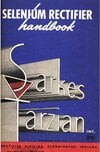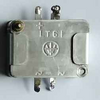Hi Everybody
I have been trying to find the data sheet and any details available of what I believe to be a selenium bridge rectifier. The component came out of a model train controller I bought way back in 1962 (How time flies!!) here in the UK. The controller was made by Hammant and Morgan who are no longer around, but collectable amongst some model train enthusiasts.
I have replaced the rectifier with a semiconductor bridge rectifier because, at 60 yrs old, I would not want the selenium rectifier to break down emitting toxic fumes. Works fine after adding a 10K resistor across the + - terminals.
I have to admit that I don't really need the info but I am just somewhat irritated as to why I have been so unsuccessful in finding the data on the internet.
The picture I have attached shows the component and a rough sketch of the small signal characteristics of one of the selenium diodes. The selenium bridge has LT61 impressed into it. The logo looks like a trident with a horizontal line across it. I can not find anything relevant pertaining to either the number or the logo.
Any comments appreciated. Cheers, all.
I have been trying to find the data sheet and any details available of what I believe to be a selenium bridge rectifier. The component came out of a model train controller I bought way back in 1962 (How time flies!!) here in the UK. The controller was made by Hammant and Morgan who are no longer around, but collectable amongst some model train enthusiasts.
I have replaced the rectifier with a semiconductor bridge rectifier because, at 60 yrs old, I would not want the selenium rectifier to break down emitting toxic fumes. Works fine after adding a 10K resistor across the + - terminals.
I have to admit that I don't really need the info but I am just somewhat irritated as to why I have been so unsuccessful in finding the data on the internet.
The picture I have attached shows the component and a rough sketch of the small signal characteristics of one of the selenium diodes. The selenium bridge has LT61 impressed into it. The logo looks like a trident with a horizontal line across it. I can not find anything relevant pertaining to either the number or the logo.
Any comments appreciated. Cheers, all.
Attachments
Last edited:




